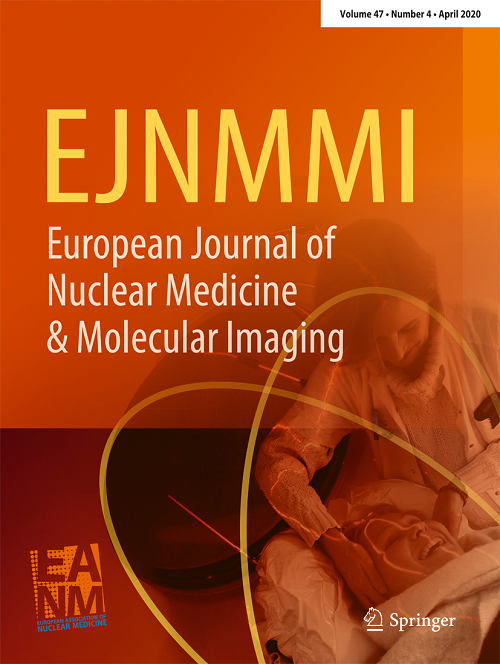Preclinical and first-in-human evaluation of novel androgen receptor-targeted PET imaging in prostate cancer.
IF 7.6
1区 医学
Q1 RADIOLOGY, NUCLEAR MEDICINE & MEDICAL IMAGING
European Journal of Nuclear Medicine and Molecular Imaging
Pub Date : 2025-09-23
DOI:10.1007/s00259-025-07577-5
引用次数: 0
Abstract
PURPOSE Activation of androgen receptor (AR) signaling is a hallmark of prostate cancer. Dynamic changes in AR expression exacerbate AR heterogeneity throughout prostate cancer therapy. This study aims to develop a series of 68Ga-labeled Enzalutamide-based positron emission tomography (PET) tracers for AR imaging. METHODS [68Ga]Ga-DOTA-FZAR-1, [68Ga]Ga-DOTA-FZAR-2, and [68Ga]Ga-DOTAGA-FZAR-3 were synthesized and the stability was analyzed in vitro. The AR specificity of the three radiotracers was assessed in vitro using AR-negative and AR-positive prostate cancer cell lines and in vivo using tumor xenograft-bearing mice. Moreover, the first-in-human evaluation of [68Ga]Ga-DOTA-FZAR-2 was conducted in eight patients with prostate cancer. RESULTS [68Ga]Ga-DOTA-FZAR-1, [68Ga]Ga-DOTA-FZAR-2, and [68Ga]Ga-DOTAGA-FZAR-3 were successfully synthesized with a radiochemical purity of more than 99%, and had good stability in vitro. Cellular uptake assays revealed that the radiotracers had the highest, intermediate, and lowest uptake in LNCaP, 22Rv1, and PC-3 cells, respectively, strongly correlating with AR expression levels (P < 0.001). Consistent with cellular uptake, the radiotracers also exhibited a hierarchical uptake pattern (highest to lowest) in tumors of mice bearing LNCaP, 22Rv1 and PC-3 xenografts, respectively. In addition, all three radiotracers were primarily eliminated through the urinary system, as confirmed by ex vivo biodistribution studies. More importantly, first-in-human investigation showed safety and diagnostic value of [68Ga]Ga-DOTA-FZAR-2 in AR-associated prostate cancer patients. CONCLUSION We developed and validated a series of 68Ga-labeled Enzalutamide-based PET tracers for AR imaging. Initial preclinical and clinical evidence indicate that [68Ga]Ga-DOTA-FZAR-2 enables noninvasive, whole-body, and dynamic monitoring of AR expression in prostate cancer patients throughout therapy.新型雄激素受体靶向PET成像在前列腺癌中的临床前和首次人体评估。
目的雄激素受体(AR)信号的激活是前列腺癌的一个标志。在前列腺癌治疗过程中,AR表达的动态变化加剧了AR的异质性。本研究旨在开发一系列68ga标记的基于enzalutamide的正电子发射断层扫描(PET)示踪剂,用于AR成像。方法合成[68Ga]Ga-DOTA-FZAR-1、[68Ga]Ga-DOTA-FZAR-2、[68Ga] ga - dota - fzar -3,并进行体外稳定性分析。在体外用AR阴性和AR阳性前列腺癌细胞系和体内用肿瘤异种移植小鼠评估三种放射性示踪剂的AR特异性。此外,在8例前列腺癌患者中进行了[68Ga]Ga-DOTA-FZAR-2的首次人体评估。结果成功合成了[68Ga]Ga-DOTA-FZAR-1、[68Ga]Ga-DOTA-FZAR-2、[68Ga] ga - dota - fzar -3,放射化学纯度大于99%,体外稳定性好。细胞摄取实验显示,放射性示踪剂在LNCaP、22Rv1和PC-3细胞中分别具有最高、中等和最低的摄取,与AR表达水平密切相关(P < 0.001)。与细胞摄取一致,放射性示踪剂在携带LNCaP、22Rv1和PC-3异种移植物的小鼠肿瘤中也分别表现出从高到低的分层摄取模式。此外,经体外生物分布研究证实,所有三种放射性示踪剂主要通过泌尿系统消除。更重要的是,首次人体研究显示了[68Ga]Ga-DOTA-FZAR-2在ar相关前列腺癌患者中的安全性和诊断价值。我们开发并验证了一系列68ga标记的基于enzalutamide的PET示踪剂用于AR成像。初步临床前和临床证据表明,[68Ga]Ga-DOTA-FZAR-2可以在整个治疗过程中对前列腺癌患者的AR表达进行无创、全身和动态监测。
本文章由计算机程序翻译,如有差异,请以英文原文为准。
求助全文
约1分钟内获得全文
求助全文
来源期刊
CiteScore
15.60
自引率
9.90%
发文量
392
审稿时长
3 months
期刊介绍:
The European Journal of Nuclear Medicine and Molecular Imaging serves as a platform for the exchange of clinical and scientific information within nuclear medicine and related professions. It welcomes international submissions from professionals involved in the functional, metabolic, and molecular investigation of diseases. The journal's coverage spans physics, dosimetry, radiation biology, radiochemistry, and pharmacy, providing high-quality peer review by experts in the field. Known for highly cited and downloaded articles, it ensures global visibility for research work and is part of the EJNMMI journal family.

 求助内容:
求助内容: 应助结果提醒方式:
应助结果提醒方式:


